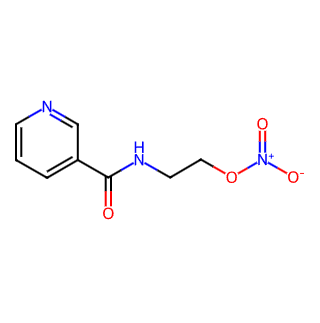- Synthetic anti-infective drugs
- Medications for the digestive system
- Antipyretic and analgesic drugs
- Medications for the blood system
- Medications for the respiratory system
- Anti-allergic drugs
- Medications for the urinary system
- Diagnostic medications
- Immunosuppressive and immunomodulatory drugs
- Vitamins and mineral supplements
- Antioxidants and medications for osteoporosis
- Antiparasitic drugs
- Ophthalmic medications
- Amino acids and their derivatives
- Dermatological medications
- Medications for the circulatory system
- Antitumor drugs
- Medications for the nervous system
- Hormonal and endocrine function-regulating drugs
- Antibiotics
- Others
CAS NO.: 65141-46-0




Basic Information
Chinese Name: 尼可地尔
English Name: Nicorandil
Alternative Names: N-[2-(Nitroxy)ethyl]-3-pyridinecarboxamide; Nicorandilum; Nicorandilate; Nicorandil Nitrate
CAS Registry Number: 65141-46-0
EINECS Number: 265-514-1
Molecular Formula: C8H9N3O4
Molecular Weight: 211.18 (Note: Minor variations such as 211.175 or 211.1748 may exist due to differences in calculation precision or standards)
Physical and Chemical Properties
Appearance: White or off-white crystalline powder, odorless or with a slight characteristic odor, bitter taste
Solubility: Soluble in ethanol, acetone, and chloroform; slightly soluble in benzene or diethyl ether; slightly soluble in water
Density: 1.331 g/cm³
Melting Point: 92°C
Boiling Point: 456.7°C
Flash Point: 230°C
Product Applications
Nicorandil is the first ATP-sensitive potassium channel opener used clinically, primarily for the prevention of angina pectoris associated with coronary heart disease. Clinical studies have confirmed that nicorandil is suitable for various types of angina pectoris, including effort angina and vasospastic angina, and it can significantly reduce the risk of cardiovascular events and improve prognosis.
Pharmacological Action
Nicorandil selectively dilates coronary arteries, consistently increasing coronary blood flow and inhibiting coronary artery spasms. Its mechanism of action involves inhibiting intracellular free calcium ions and increasing potassium ion permeability on the cell membrane, resulting in vasodilation and inhibition of coronary artery spasms. Additionally, nicorandil has antiplatelet aggregation and antithrombotic effects.

Tai Yau Street, San Po Kong, Kowloon, Hong Kong, China.



